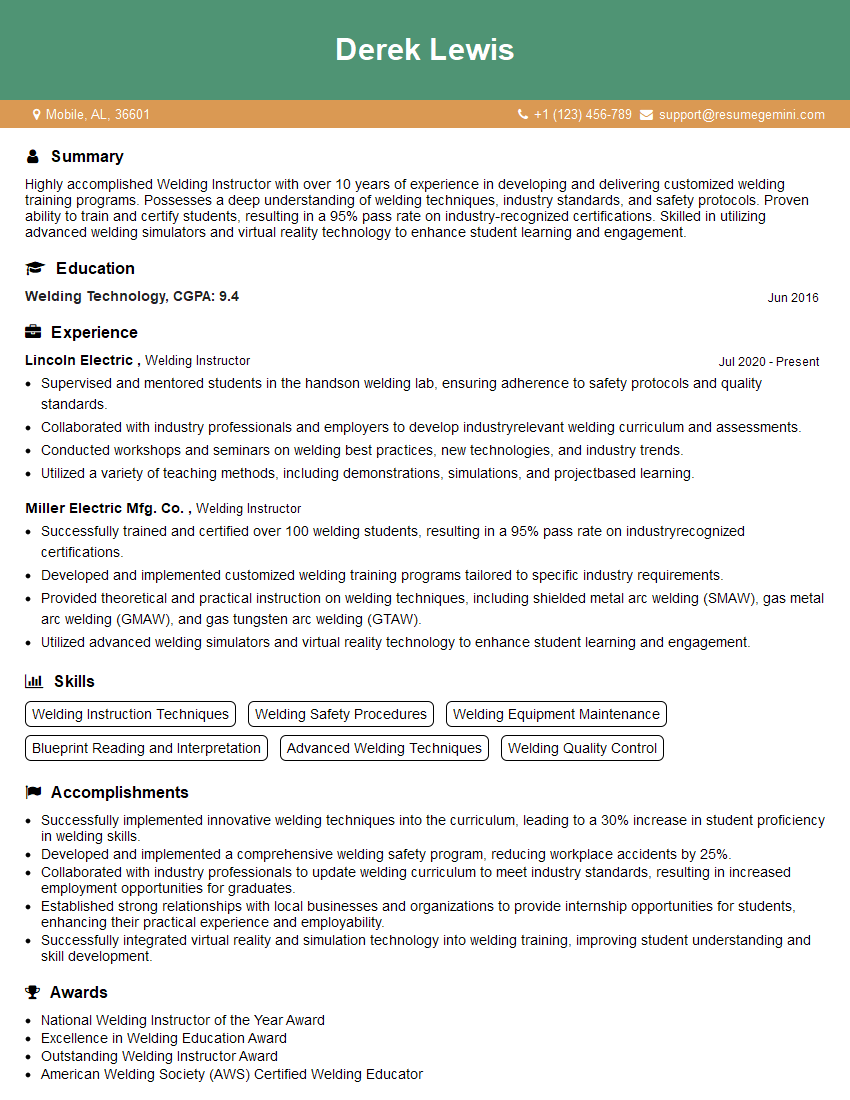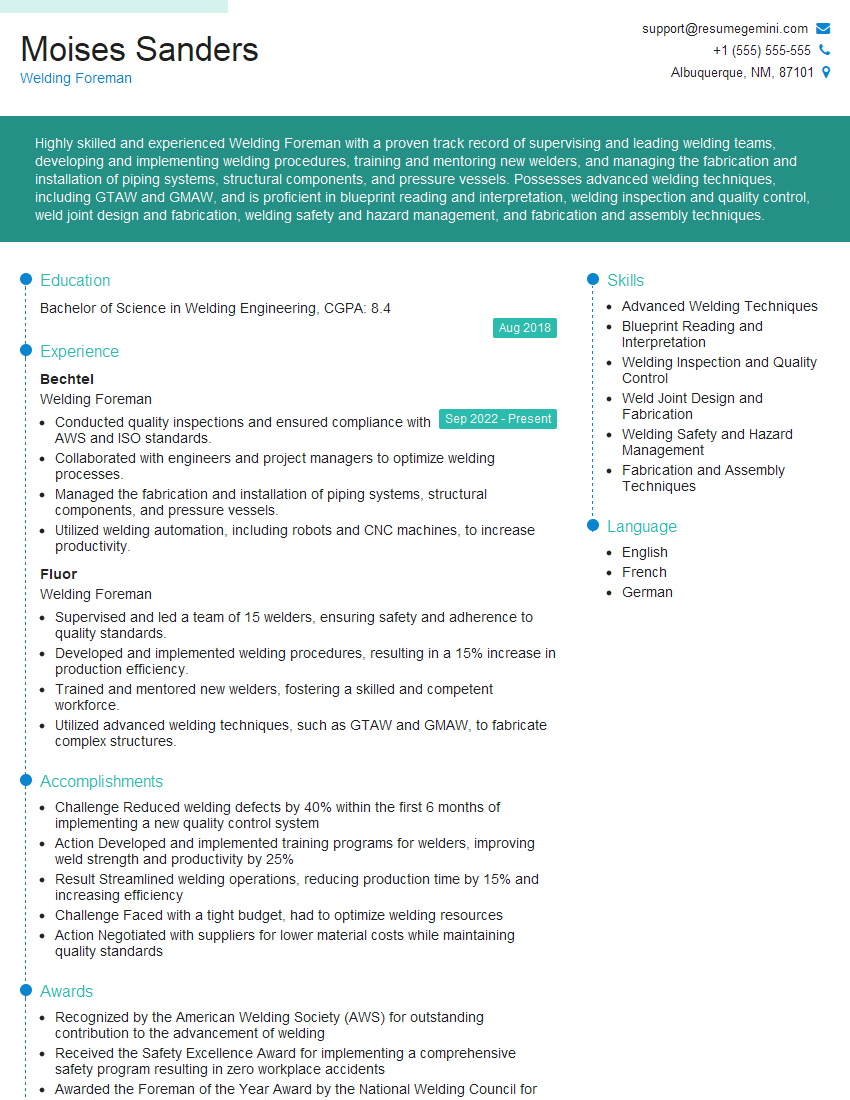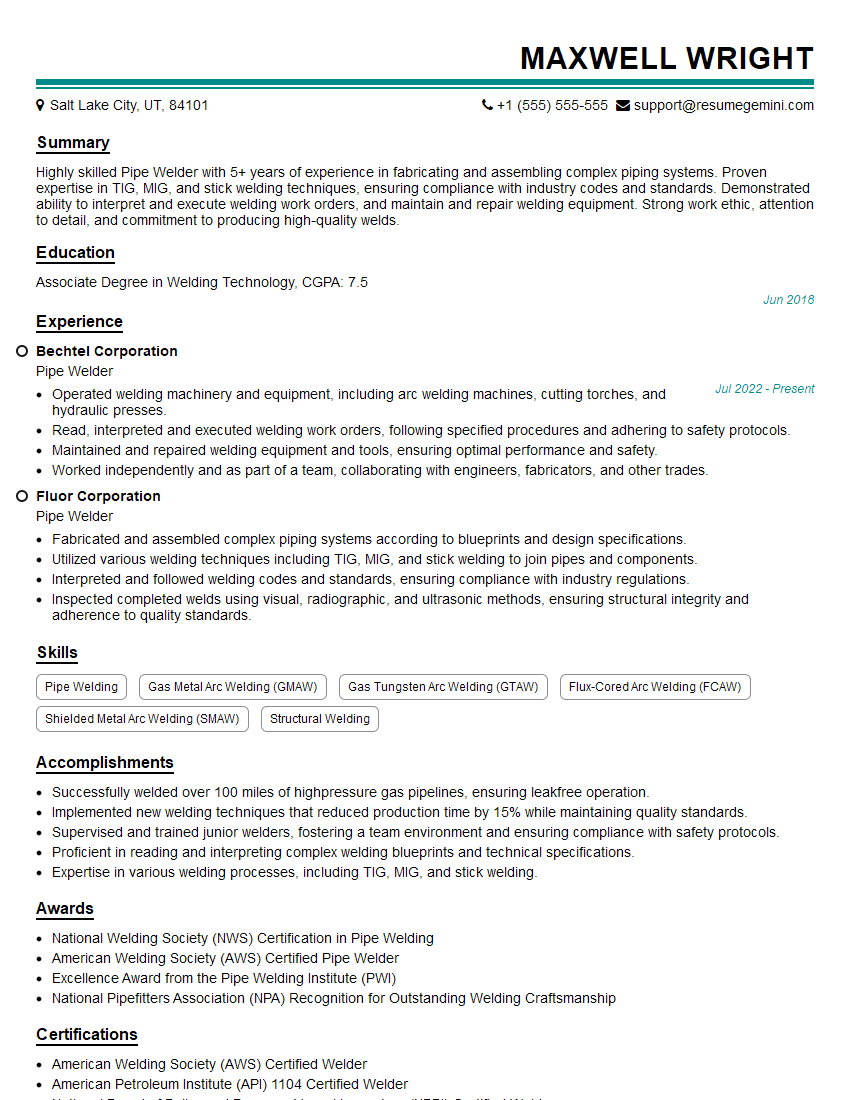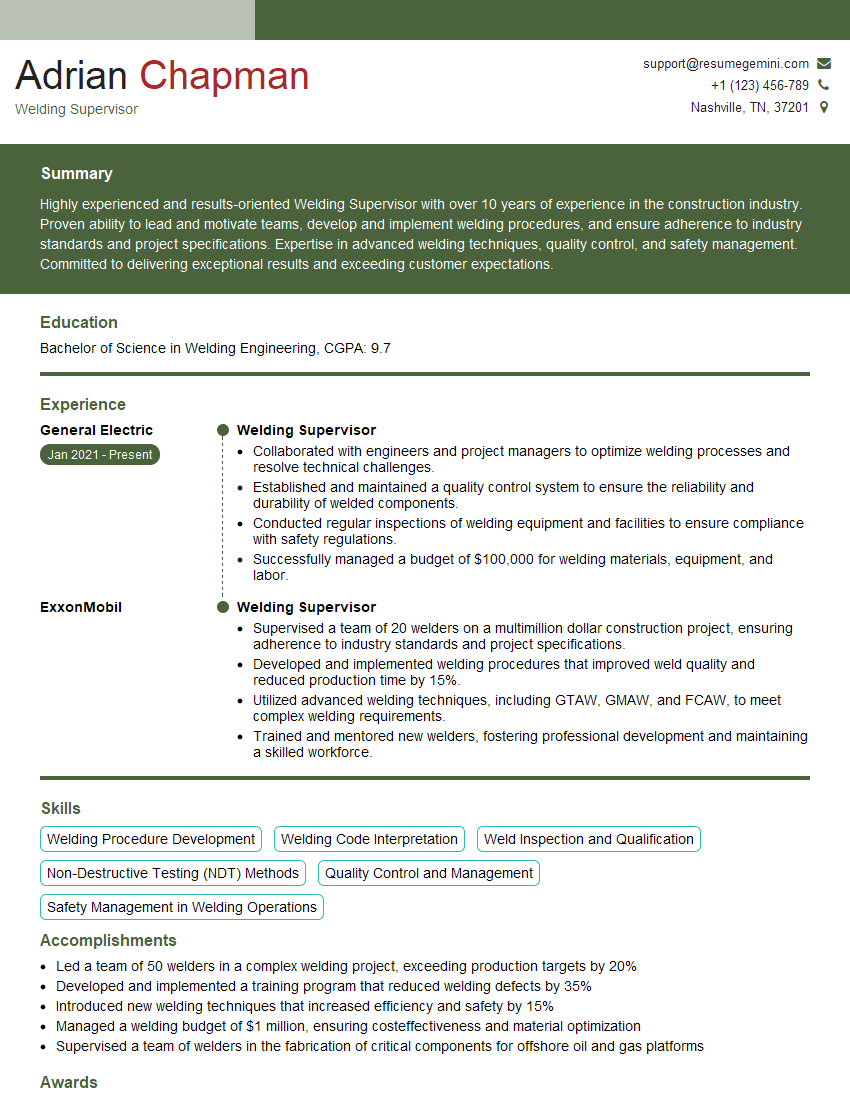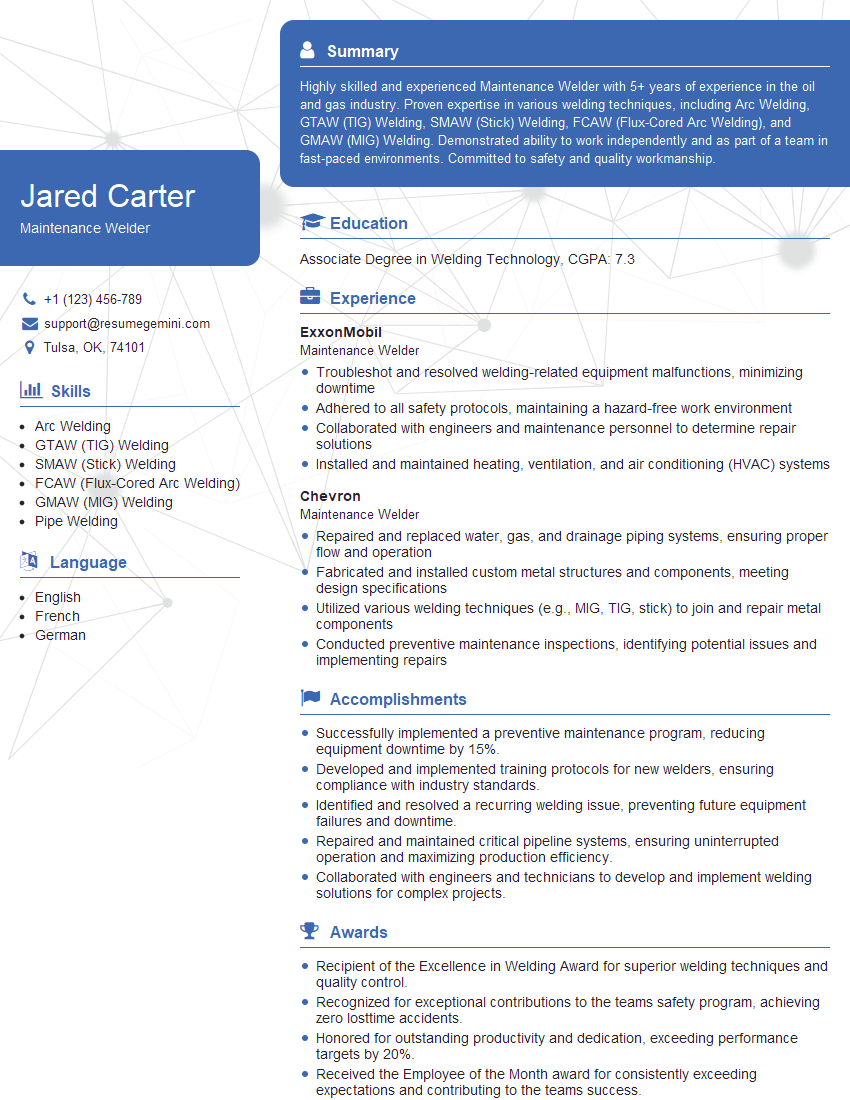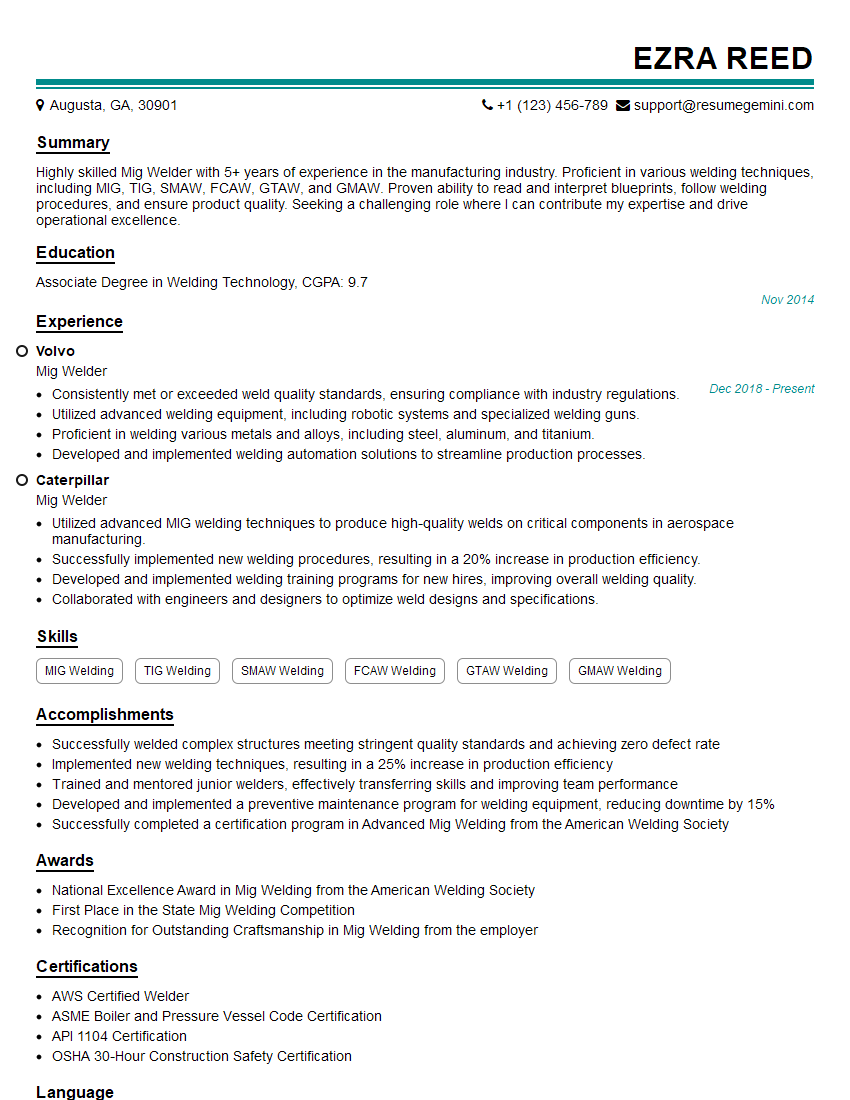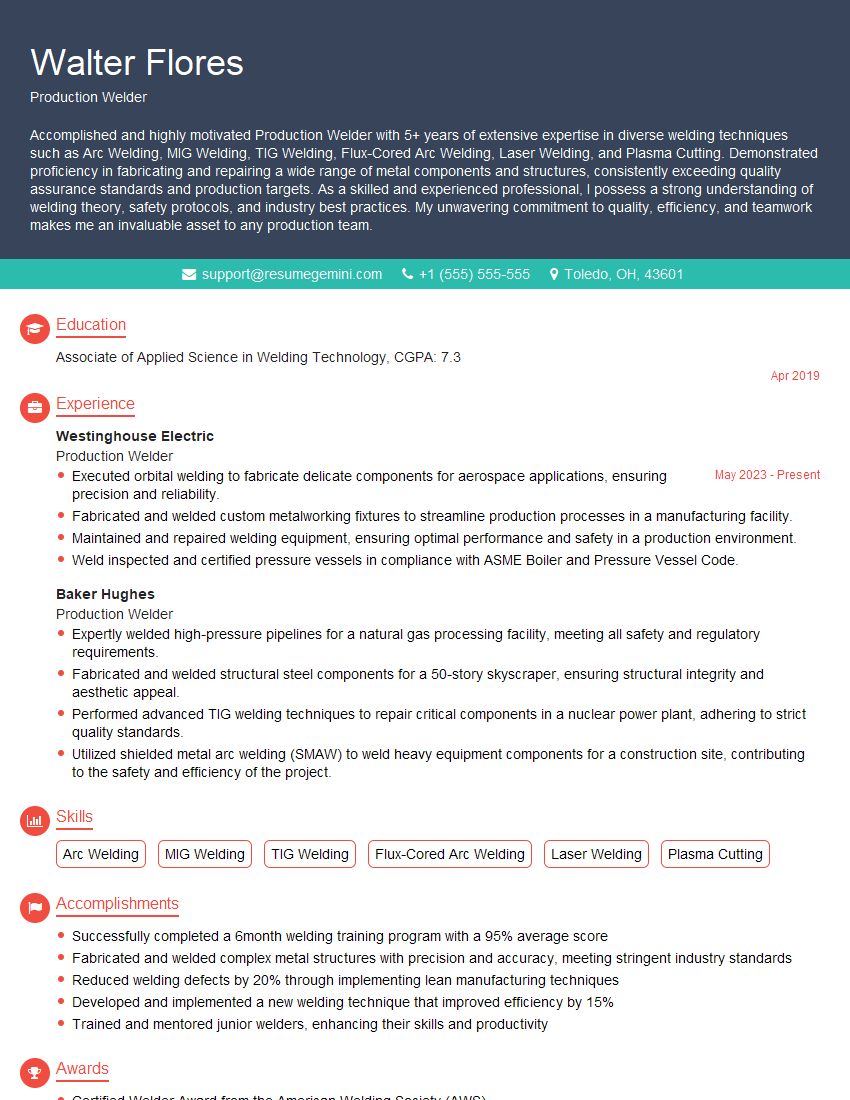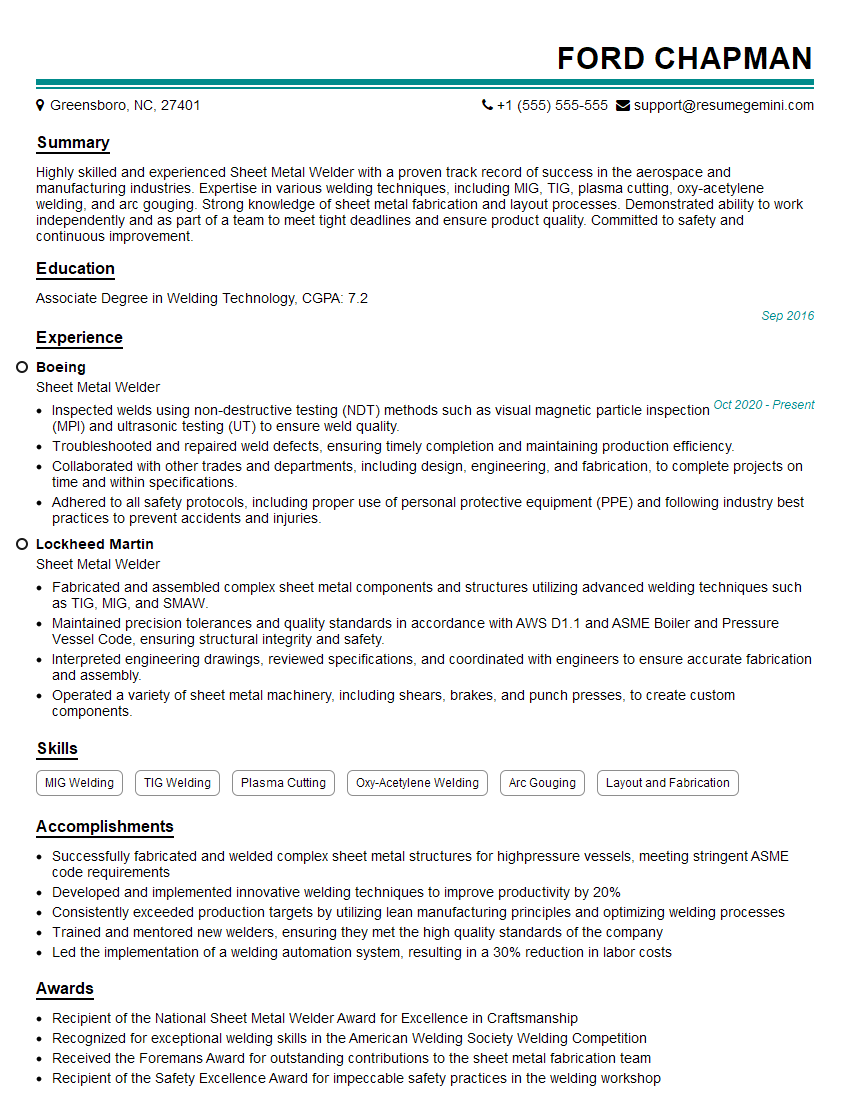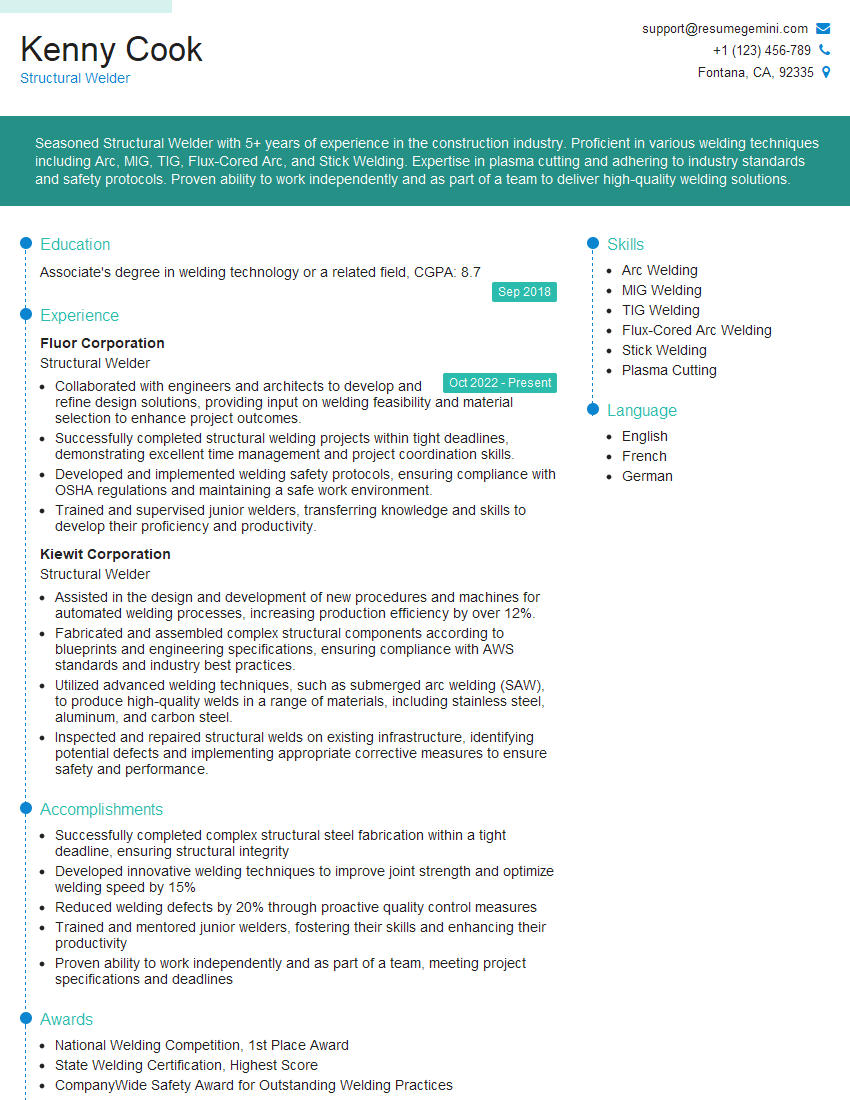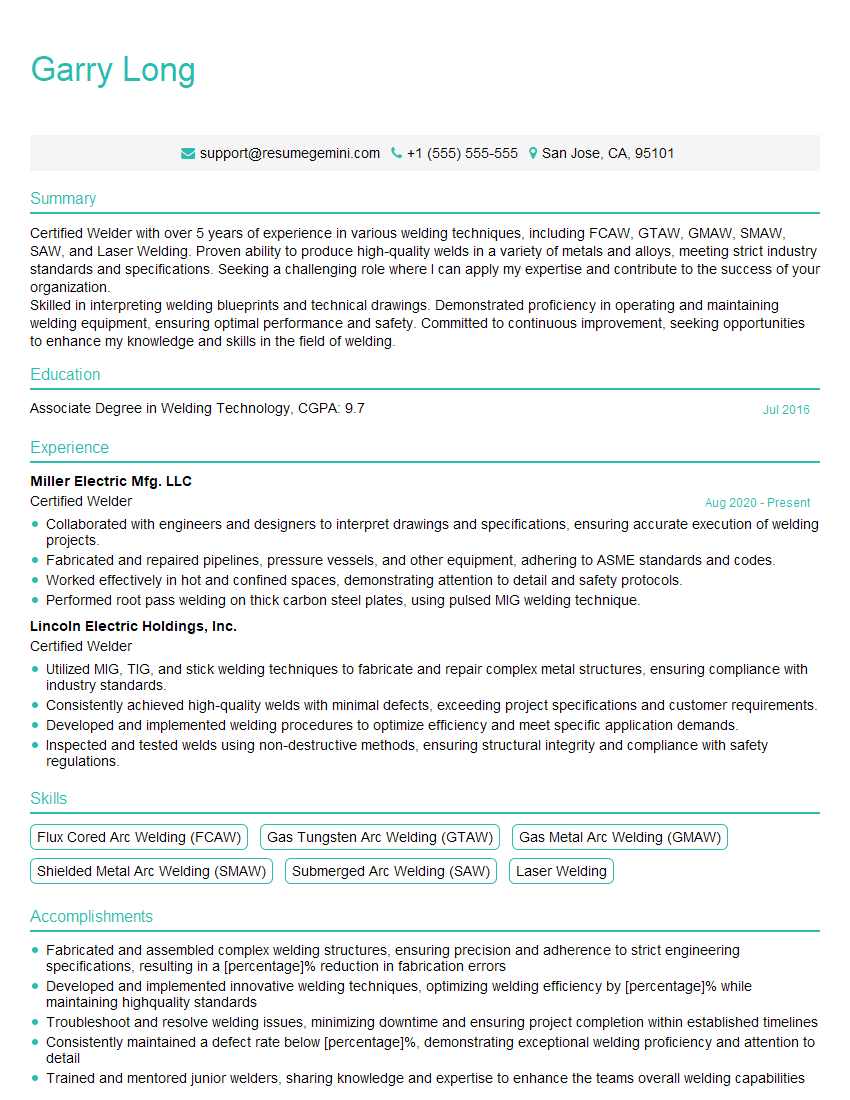Unlock your full potential by mastering the most common Welding Operation interview questions. This blog offers a deep dive into the critical topics, ensuring you’re not only prepared to answer but to excel. With these insights, you’ll approach your interview with clarity and confidence.
Questions Asked in Welding Operation Interview
Q 1. Explain the difference between MIG and TIG welding.
MIG (Metal Inert Gas) and TIG (Tungsten Inert Gas) welding are two popular arc welding processes, but they differ significantly in their techniques and applications. Think of it like this: MIG is like using a spray can – fast and efficient for covering large areas, while TIG is like using a fine paintbrush – precise and ideal for intricate details.
MIG Welding: Uses a consumable electrode (wire) that feeds continuously into the weld pool, acting as both the electrode and filler material. A shielding gas (usually argon or a mixture of argon and carbon dioxide) protects the weld from atmospheric contamination. It’s known for its speed and ease of use, making it suitable for mass production and large-scale projects. For example, MIG welding is commonly used in automotive manufacturing for body panels and chassis construction.
TIG Welding: Employs a non-consumable tungsten electrode to create the arc. Filler material is added separately using a filler rod. A shielding gas (usually argon or helium) provides protection. TIG welding offers superior control and produces cleaner, higher-quality welds, making it ideal for applications requiring precision and high-strength joints. Think of aircraft manufacturing or welding thin stainless steel components – TIG’s precision shines in these situations.
- Key Difference Summary: MIG uses a consumable electrode and is faster; TIG uses a non-consumable electrode and offers greater precision.
Q 2. Describe the various types of welding joints.
Welding joints are classified based on the way the materials are joined. Understanding these types is crucial for selecting the appropriate welding process and ensuring a strong, reliable weld.
- Butt Joint: The simplest type, where two pieces are joined end-to-end. It can be square butt, bevel butt, or lap butt, depending on edge preparation.
- Lap Joint: One piece overlaps the other. The overlap can be single or double.
- T-Joint: One piece is perpendicular to another, forming a ‘T’ shape. It can be a tee joint or corner joint.
- Edge Joint: The edges of two pieces are butted together, but unlike a butt joint, no edge preparation is done.
- Corner Joint: Two pieces are joined at an angle, forming an internal or external corner.
- Mitre Joint: Two pieces are joined at an angle, creating a mitre.
The choice of joint type depends on factors such as the thickness of the materials, the required strength, and the accessibility of the joint. For instance, a butt joint is suitable for thick plates needing high strength, while a lap joint is convenient for thinner materials and easier accessibility.
Q 3. What are the safety precautions for welding operations?
Welding poses significant safety risks if precautions aren’t taken. Imagine the intense heat, bright light, and potential for sparks and fumes – safety is paramount!
- Personal Protective Equipment (PPE): This is non-negotiable. Always wear a welding helmet with appropriate shade lenses to protect your eyes from arc flash, welding gloves to protect your hands from burns, and protective clothing (e.g., leather jacket, pants) to cover exposed skin.
- Ventilation: Welding produces fumes that can be toxic. Ensure adequate ventilation or use a respirator, especially in confined spaces. Some fumes are invisible and just as dangerous!
- Fire Safety: Keep a fire extinguisher nearby, and ensure the welding area is free of flammable materials. Sparks can easily ignite anything combustible.
- Eye and Skin Protection: Always wear proper eye protection (auto-darkening helmets are preferred) and protect your skin. UV radiation can damage your eyes and cause sunburn-like effects, even through clothing.
- Grounding: Properly ground all equipment to prevent electric shock.
- Proper Training: Always receive comprehensive training before undertaking any welding work. Knowing the risks and proper procedures is crucial.
Following these safety procedures significantly reduces the risk of injury and ensures a safe working environment.
Q 4. How do you identify and correct welding defects?
Identifying and correcting welding defects is crucial for ensuring structural integrity and safety. Think of it as a quality control process.
Identification: Defects can be visual (porosity, cracks, undercuts) or detected through non-destructive testing (NDT) methods like radiography (X-ray) or ultrasonic testing. Visual inspection often reveals surface defects like incomplete fusion or excessive penetration. NDT methods help detect internal flaws.
Correction: The approach depends on the nature and severity of the defect. Minor defects might be acceptable if they don’t compromise structural integrity. More serious defects require repair, which might involve grinding out the defect, re-welding, or even replacing the entire component. For example, a crack would require significant repair, while minor porosity may only need a light grind if it’s superficial.
Example: If a weld shows excessive porosity (small holes), it could indicate issues with the shielding gas, improper welding parameters (current, voltage, speed), or contaminated materials. The solution would involve addressing the root cause – perhaps cleaning the materials, adjusting welding parameters, or ensuring a better gas flow.
Q 5. Explain the importance of pre-weld inspection.
Pre-weld inspection is critical for preventing defects and ensuring a successful weld. It’s like preparing the canvas before painting a masterpiece.
Importance: Pre-weld inspection involves checking the base materials for cleanliness, surface defects (e.g., cracks, rust, contamination), proper fit-up of the joint, and ensuring the correct materials are being used. This prevents issues that could lead to weld defects during the welding process. Imagine trying to weld two rusty pieces – the weld will be weak and prone to failure. Pre-weld inspection helps catch such problems before welding even begins.
Procedure: Typically includes visual inspection, checking material specifications, ensuring proper fit-up of the parts being joined, and cleaning the surfaces to be welded (removing any contaminants like grease, rust, or paint). Thorough cleaning and preparation are key to prevent weld defects.
Impact: By identifying and addressing potential issues before welding, pre-weld inspection saves time, materials, and reduces the risk of costly rework or failures. This proactive approach is vital to ensuring the quality and integrity of the final weld.
Q 6. What are the different types of filler metals used in welding?
The filler metal is the material added to the weld joint to fill the gap and create the weld. The choice of filler metal is critical for achieving desired weld properties.
- Steel: Various types, including low-carbon steel, medium-carbon steel, and high-carbon steel, are available, each with different mechanical properties. The choice depends on the application and required strength.
- Stainless Steel: Offers corrosion resistance, used in applications where corrosion is a concern.
- Aluminum: Used for lightweight structures and applications requiring high corrosion resistance.
- Nickel Alloys: Known for high strength and corrosion resistance at high temperatures, used in specialized applications.
- Copper Alloys: Used for electrical applications or where high thermal conductivity is needed.
Filler metals are selected based on factors such as the base material being welded, the required mechanical properties of the weld, and the welding process being used. Selecting the wrong filler metal can lead to weak welds, cracking, or other defects.
Q 7. How do you select the appropriate welding process for a specific material?
Selecting the right welding process for a specific material is crucial for achieving a high-quality weld. It’s like choosing the right tool for the job.
Factors to Consider:
- Material Type: Different materials require different welding processes. For example, thin sheet metal is often TIG welded for precision, while thicker steel might be MIG welded for speed. Stainless steel often requires specialized filler metals and processes to prevent corrosion.
- Material Thickness: Thicker materials may require higher current and different processes compared to thinner ones.
- Joint Design: The joint type influences the choice of process; for example, a butt joint may need different edge preparation for various processes.
- Weld Quality Requirements: Applications requiring high-quality, visually appealing welds are often best suited to TIG or specialized processes, while applications that prioritize speed and efficiency might opt for MIG or other faster processes.
- Accessibility: Some processes are more suitable for hard-to-reach areas.
Example: Welding thin aluminum sheet metal would necessitate TIG welding due to its precision and control, preventing burn-through. Welding thick steel plates in a construction setting could efficiently use MIG or Flux-Cored Arc Welding (FCAW) for higher deposition rates.
Careful consideration of these factors ensures the selected welding process effectively joins the materials, meets the required quality standards, and completes the project efficiently.
Q 8. Explain the concept of weld penetration and its significance.
Weld penetration refers to the depth to which the weld extends into the base material. Think of it like this: you’re gluing two pieces of wood together; the penetration is how far the glue seeps into each piece, creating a strong bond. Sufficient penetration is crucial for a strong, reliable weld. Insufficient penetration results in a weak joint prone to failure, while excessive penetration can lead to weld cracking or burn-through. The desired penetration depth is determined by the thickness of the base material and the application’s required strength. For instance, a weld joining thick steel plates for a bridge requires significantly more penetration than a weld joining thin sheets for a small appliance.
Factors influencing penetration include the welding process (e.g., GMAW, SMAW), the welding parameters (e.g., current, voltage, travel speed), and the electrode type and filler material. Proper joint design also plays a significant role. A well-designed joint ensures consistent heat distribution and proper fusion, optimizing penetration.
Q 9. Describe the different types of welding electrodes.
Welding electrodes come in various types, each designed for specific applications and materials. The most common classifications are based on their coating type and composition:
- Shielded Metal Arc Welding (SMAW) Electrodes: These electrodes are coated with a flux that protects the weld from atmospheric contamination and provides additional alloying elements. Common types include E6010 (fast freezing, good for out-of-position welding), E7018 (low hydrogen, ideal for critical applications), and E6013 (general purpose, easy to use).
- Gas Metal Arc Welding (GMAW) Electrodes (Wire Feed): In GMAW, the electrode is a continuously fed wire, often solid or metal-cored. Solid wire offers good versatility, while metal-cored wires provide superior penetration and better bead appearance. The choice depends on factors such as the material being welded and the required weld strength.
- Gas Tungsten Arc Welding (GTAW) Electrodes (Non-Consumable): In GTAW (TIG welding), the electrode is a non-consumable tungsten rod that produces an arc to melt the base material and filler metal. Tungsten electrodes are classified by their purity and thoriated or ceriated variants provide improved arc characteristics.
The choice of electrode depends on many factors, including the base material (steel, aluminum, stainless steel), the desired weld properties (strength, toughness, corrosion resistance), and the welding position (flat, vertical, overhead).
Q 10. What are the factors that affect weld quality?
Weld quality is paramount in ensuring structural integrity and safety. Many factors influence it, and they can be broadly categorized as:
- Welding Process Parameters: Current, voltage, travel speed, and shielding gas flow rate are crucial. Incorrect settings can lead to poor penetration, excessive spatter, or porosity.
- Base Material: The cleanliness, composition, and thickness of the base material significantly impact weld quality. Surface contamination, such as rust or grease, can lead to poor fusion and defects.
- Electrode/Filler Material Selection: Using the wrong electrode type or filler metal can lead to poor weld metal properties, such as reduced strength or increased susceptibility to cracking.
- Joint Design and Preparation: Proper joint design and preparation, including edge beveling and cleaning, ensure proper fit-up and heat distribution, leading to better fusion and penetration.
- Operator Skill: Experienced welders possess the necessary skill to control the welding process, maintain consistent parameters, and identify and correct potential issues.
- Environmental Conditions: Wind, rain, or extreme temperatures can negatively affect weld quality by disrupting the arc or cooling the weld too quickly.
Regular quality control checks, such as visual inspection and non-destructive testing (NDT), are crucial to ensure consistent weld quality.
Q 11. How do you interpret welding symbols?
Welding symbols are a standardized way to communicate weld requirements on engineering drawings. They provide concise information about weld type, size, location, and other relevant details. A typical symbol includes:
- Reference Line: A horizontal line representing the weld location.
- Arrow Side: The side of the joint where the symbol is placed indicates the location of the weld on that side.
- Basic Weld Symbol: Represents the type of weld (e.g., fillet, groove, spot).
- Dimensional Data: Indicates the weld size (leg length for fillet welds, throat for groove welds).
- Other Designations: Symbols for field welds, special processes, and other details might be present.
For instance, a symbol showing a triangle on the arrow side indicates a fillet weld, while the numbers next to it signify the leg length. A detailed understanding of these symbols is essential for welders to correctly execute the weld according to the design specifications. Incorrect interpretation can lead to serious consequences.
Q 12. Explain the importance of proper shielding gas in welding.
Proper shielding gas is critical in various welding processes, particularly Gas Metal Arc Welding (GMAW) and Gas Tungsten Arc Welding (GTAW), to protect the weld from atmospheric contamination. The atmosphere contains oxygen, nitrogen, and moisture, which can react with the molten weld pool, causing defects such as porosity, cracking, and reduced weld strength. Shielding gas forms a protective blanket around the weld, preventing these reactions.
Common shielding gases include Argon (Ar), Helium (He), and mixtures like Argon-CO2. The choice of gas depends on the welding process and the base material. For instance, Argon is commonly used for welding aluminum and stainless steel because it provides excellent arc stability and shielding. Argon-CO2 mixtures are often used for steel welding to improve penetration and increase the deposition rate. Inadequate gas flow can lead to oxidation or porosity, compromising weld integrity.
Q 13. What are the common causes of weld porosity?
Weld porosity, the presence of small holes or voids in the weld metal, significantly reduces weld strength and fatigue life. Several factors contribute to its formation:
- Moisture Contamination: Moisture in the base material, electrode coating, or shielding gas can vaporize during welding, creating pores.
- Poor Shielding: Insufficient or turbulent shielding gas flow allows atmospheric gases to enter the weld pool.
- Excessive Welding Speed: Rapid welding speed can trap gases in the weld pool before they can escape.
- Incorrect Welding Parameters: Improper current, voltage, or travel speed settings can also trap gases and create porosity.
- Contamination of Filler Metal: Impurities or oxides in the filler metal can lead to gas formation and porosity.
Preventing porosity requires careful attention to cleanliness, proper shielding, optimized welding parameters, and using high-quality materials.
Q 14. How do you troubleshoot a welding machine malfunction?
Troubleshooting welding machine malfunctions requires a systematic approach. Here’s a step-by-step guide:
- Safety First: Disconnect the power supply before performing any inspection or repair.
- Visual Inspection: Carefully examine the machine for any obvious issues like loose connections, damaged cables, or visible damage.
- Check Power Supply: Ensure that the power supply is properly connected and that the voltage is correct.
- Check Input Voltage and Current Readings: Consult the machine’s manual for specifications to confirm readings are correct.
- Inspect Gas Flow (if applicable): Verify that gas cylinders are full and that the gas flow rate is appropriate.
- Check for Grounding: A faulty ground can disrupt the welding arc and cause problems. Ensure a good connection to the ground.
- Test the Circuit Breakers: Try resetting circuit breakers if they’ve tripped.
- Consult the Manual: The operator’s manual contains troubleshooting guides and diagnostic codes that might pinpoint the problem.
- Professional Help: If you are unable to identify and rectify the issue, contact a qualified technician or welding equipment specialist.
Remember, working with welding equipment requires proper safety precautions. Always refer to the manufacturer’s instructions and use appropriate personal protective equipment (PPE).
Q 15. Describe your experience with different welding positions (e.g., 1G, 2G, 3G, 4G).
Welding positions, designated by the American Welding Society (AWS) as 1G, 2G, 3G, and 4G, define the orientation of the weld joint relative to gravity. This impacts the weld pool’s behavior and the welder’s technique. My experience spans all four positions, requiring adaptability and precise control.
- 1G (Flat): The simplest, with the weld joint horizontal and the weld pool resting freely. This is ideal for learning fundamental techniques.
- 2G (Horizontal): The weld is vertical, but the weld pool flows downwards, requiring careful control to prevent sagging or excessive penetration. I’ve used this position extensively on pipe welding projects.
- 3G (Vertical): This involves welding upwards or downwards on a vertical joint. Upward welding (3GR) demands precise control of the arc and bead shaping to prevent the molten metal from running down the weld. Downward welding (3GD) can be easier but also requires skill to maintain a consistent weld bead. I’ve encountered this in structural steel fabrication.
- 4G (Overhead): The most challenging position, requiring superior technique to control the weld pool against gravity. Overhead welds are common in pipe and structural work. Maintaining a stable arc and preventing weld spatter are critical here. My experience includes overhead welding on intricate pipe junctions.
Throughout my career, I’ve routinely adapted my techniques to suit various positions, demonstrating consistent quality across all four.
Career Expert Tips:
- Ace those interviews! Prepare effectively by reviewing the Top 50 Most Common Interview Questions on ResumeGemini.
- Navigate your job search with confidence! Explore a wide range of Career Tips on ResumeGemini. Learn about common challenges and recommendations to overcome them.
- Craft the perfect resume! Master the Art of Resume Writing with ResumeGemini’s guide. Showcase your unique qualifications and achievements effectively.
- Don’t miss out on holiday savings! Build your dream resume with ResumeGemini’s ATS optimized templates.
Q 16. What is your experience with different welding processes (e.g., SMAW, GMAW, GTAW, FCAW)?
My expertise includes several welding processes, each suited for different applications and materials.
- SMAW (Shielded Metal Arc Welding): A versatile process using a coated electrode, ideal for various metals in diverse environments. My experience with SMAW includes repairs on heavy machinery and structural steel fabrication. I’m proficient in selecting electrodes based on material thickness and required weld properties.
- GMAW (Gas Metal Arc Welding): A high-deposition process using a continuous wire electrode fed through a shielding gas. I’ve extensively used GMAW in automotive applications and high-volume production environments, appreciating its speed and efficiency. I’m familiar with various transfer modes (spray, short circuiting, pulsed) and their applications.
- GTAW (Gas Tungsten Arc Welding): A precise process that produces high-quality welds. My GTAW experience involves welding thinner materials and applications requiring excellent appearance and minimal heat input, such as on stainless steel piping. This technique demands greater precision and control.
- FCAW (Flux-Cored Arc Welding): This method utilizes a tubular electrode containing its own flux. It’s particularly useful in outdoor environments, offering good penetration and productivity. I’ve used FCAW extensively in heavy construction and fabrication projects because of its ability to minimize the effects of wind and moisture.
My proficiency encompasses choosing the right process for a given job, considering factors such as material, thickness, joint design, and the environment.
Q 17. How do you ensure compliance with welding codes and standards (e.g., AWS D1.1)?
Adherence to welding codes and standards is paramount. My experience centers around AWS D1.1, the Structural Welding Code – Steel. I ensure compliance through meticulous adherence to procedure specifications (WPS), which detail all critical parameters for a given weld, including the process, materials, preheating requirements and post-weld heat treatments (PWHT) if required.
Before starting any welding project, I verify that the WPS is qualified and approved, ensuring the procedures are current and in line with the project requirements. This involves examining the WPS for details on electrode type, shielding gas composition, travel speed, amperage, voltage, and pre and post-heat temperatures. I maintain precise records of my work to ensure traceability and auditability.
Furthermore, I’m familiar with other relevant codes and standards, adapting my approach as needed. Regular training keeps my knowledge of these regulations up-to-date, ensuring the highest quality and safety standards are met.
Q 18. What is your experience with Non-Destructive Testing (NDT) methods used in welding?
Non-Destructive Testing (NDT) is crucial for verifying weld integrity. I have experience with several common NDT methods:
- Visual Inspection (VT): The most basic method, checking for surface flaws like cracks, porosity, or undercuts. I regularly perform VT as a first step in assessing weld quality.
- Radiographic Testing (RT): Using X-rays or gamma rays to detect internal flaws. I’ve worked with RT reports, interpreting radiographs to identify and assess subsurface defects.
- Ultrasonic Testing (UT): Employing high-frequency sound waves to detect internal flaws. I understand the principles of UT and can interpret ultrasonic test results to determine the severity of any detected flaws.
- Magnetic Particle Testing (MT): Used to detect surface and near-surface flaws in ferromagnetic materials. I’m familiar with the interpretation of MT results and can identify indications caused by cracks or other discontinuities.
My understanding of NDT methodologies allows me to assess weld quality comprehensively and identify potential problems early in the process, leading to more reliable and safer structures.
Q 19. Describe your experience with blueprint reading and interpretation for welding.
Blueprint reading is a fundamental skill. I’m proficient in interpreting welding symbols, dimensions, tolerances, and material specifications. A welding symbol provides all necessary information, including the type of weld, location, dimensions, and specifications for the weld preparation. I can quickly and accurately extract relevant details. This includes understanding weld joint types (butt, fillet, lap, T-joint), weld preparation (bevel, groove), and dimensional tolerances.
For example, I can decipher a symbol specifying a fillet weld of a certain size, located on a specific part of the joint. I use this information to set up my equipment and perform the weld according to the blueprint’s specifications, ensuring the final product meets the required standards.
I’ve worked on complex projects requiring detailed blueprint interpretation. I’m adept at identifying potential challenges based on the design and proactively addressing them to deliver high-quality results.
Q 20. How do you maintain welding equipment and ensure its safe operation?
Maintaining welding equipment and ensuring safe operation are paramount. I follow a rigorous routine of preventative maintenance, including regular cleaning, inspections, and lubrication of equipment.
This involves:
- Daily Checks: Inspecting cables for damage, checking gas pressure and flow rates, ensuring proper grounding, and verifying that all safety equipment (PPE) is functional.
- Routine Maintenance: Cleaning the contact tips and nozzles regularly on GMAW machines, replacing worn parts, and ensuring the shielding gas is correctly supplied.
- Scheduled Inspections: Following a manufacturer-recommended schedule for more involved maintenance tasks. This ensures all components are in optimal working condition.
I always prioritize safety, ensuring the equipment complies with all safety regulations. This includes using appropriate PPE, maintaining a clean and organized workspace, and being aware of potential hazards.
Q 21. Explain your experience with different types of welding consumables.
Welding consumables significantly impact the weld quality. My experience encompasses a wide range:
- Electrodes (SMAW): I’m familiar with various electrode classifications (e.g., E6010, E7018) and their properties, choosing the right electrode based on the material, joint design, and required weld properties. This includes understanding the effects of different coatings on arc stability, penetration, and weld bead appearance.
- Welding Wire (GMAW/FCAW): I have experience with different wire types (solid, flux-cored), diameters, and compositions. The selection depends on the material being welded, the required weld characteristics, and the welding process parameters.
- Tungsten Electrodes (GTAW): I’m familiar with various tungsten electrode types (pure tungsten, thoriated, ceriated) and their effects on arc characteristics and weld quality. The selection depends on the welding process and the material being welded.
- Shielding Gases: I understand the properties of various shielding gases (argon, helium, CO2, mixtures) and their impact on weld formation. My experience includes optimizing gas mixtures for different applications to ensure efficient and effective shielding of the weld pool.
Careful selection and proper handling of consumables are key to achieving high-quality, consistent welds.
Q 22. How do you handle different types of metal and alloys in welding?
Handling different metals and alloys in welding requires a deep understanding of their properties and the appropriate welding techniques. Each metal has a unique melting point, thermal conductivity, and susceptibility to cracking or warping. The choice of filler metal, welding process, and parameters (like amperage and voltage) are all crucial.
- Steel: A common material, requiring careful attention to preheating and post-weld heat treatment, especially for thicker sections to prevent cracking. Different grades of steel (e.g., mild steel, stainless steel, high-strength low-alloy steel) require different filler metals and welding processes.
- Aluminum: Known for its high thermal conductivity, requiring a higher amperage to achieve a proper weld pool. Special cleaning procedures are needed to remove the oxide layer on the surface before welding. Gas metal arc welding (GMAW) or gas tungsten arc welding (GTAW) are commonly used.
- Stainless Steel: Susceptible to porosity and cracking if not welded correctly. Proper shielding gas selection (often argon or a mixture of argon and helium) is critical to protect the weld from atmospheric contamination. GTAW and GMAW with special filler metals are typically employed.
- Titanium: Extremely reactive with atmospheric gases, requiring a high-purity shielding gas environment and specialized welding procedures like GTAW in a controlled atmosphere or vacuum.
For instance, welding thin stainless steel requires a lower amperage and faster travel speed to prevent burn-through, while thicker sections necessitate higher amperage and slower speed. I always ensure I consult material datasheets and welding procedure specifications to ensure a sound and safe weld.
Q 23. Describe your experience with different types of welding power sources.
My experience encompasses various welding power sources, each with its own characteristics and applications. Understanding their capabilities and limitations is vital for producing high-quality welds.
- Constant Current (CC) Power Sources: Ideal for SMAW (Shielded Metal Arc Welding) and some GTAW applications. They maintain a relatively constant current regardless of arc length fluctuations, providing a stable arc and easier control of penetration.
- Constant Voltage (CV) Power Sources: Commonly used in GMAW (Gas Metal Arc Welding) and some FCAW (Flux-Cored Arc Welding). They provide a constant voltage, allowing for better control of the weld bead’s width and shape. The amperage adjusts automatically based on arc length.
- Pulse Power Sources: Offer precise control over the welding process by varying the current between high and low pulses. This results in improved weld quality, reduced spatter, and better control of heat input, particularly beneficial for thin materials or delicate applications.
In practice, I’ve used CC power sources for manual stick welding on heavy structural steel, while CV sources have been essential for automated GMAW processes in production environments. Understanding the interaction between the power source, the welding process, and the material being welded is crucial for optimal performance.
Q 24. How do you calculate the required weld size for a given application?
Calculating the required weld size involves considering several factors: the type of joint, the applied load, the material’s tensile strength, the weld’s efficiency, and the safety factor. There is no single formula, rather a systematic approach.
The basic principle is to ensure the weld has sufficient strength to withstand the anticipated loads. This is often done using engineering calculations based on stress analysis, or through references to relevant welding codes (e.g., ASME Section IX, AWS D1.1). These codes provide guidelines on minimum weld sizes for specific applications.
For example, consider a lap joint in a steel structure subjected to a tensile load. We’d calculate the required weld area based on the load, the material’s ultimate tensile strength, and a suitable safety factor (typically 2 or higher). We then choose a weld size that provides at least this area, considering the weld’s geometry (e.g., fillet weld or butt weld) and the weld metal’s efficiency. Software tools and handbooks are frequently used to aid in these complex calculations.
Q 25. What is your understanding of heat treatment post-welding?
Post-weld heat treatment (PWHT) is a crucial step in many welding applications, aimed at relieving residual stresses introduced during the welding process. These stresses can lead to cracking, distortion, and reduced component life. The type and parameters of PWHT depend on the material, the weld size, and the application’s requirements.
- Stress Relief Annealing: This is the most common type of PWHT, involving heating the welded component to a specific temperature (typically below the critical transformation temperature), holding it at that temperature for a predetermined time, and then slowly cooling it. This reduces residual stresses without significantly altering the material’s microstructure.
- Normalizing: This involves heating the welded component above the upper critical temperature, holding it, and then air cooling it. This process refines the grain structure and improves the mechanical properties.
- Tempering: Primarily applied to hardened steels, tempering reduces brittleness while maintaining some hardness.
For instance, welding thick sections of high-strength steel often requires stress relief annealing to prevent cracking. Failure to properly perform PWHT could lead to premature failure of the welded component in service. Always check the welding procedure specification (WPS) for specific PWHT instructions.
Q 26. Explain the importance of proper joint preparation before welding.
Proper joint preparation is paramount for achieving strong, sound, and reliable welds. It ensures proper fusion between the base metals and minimizes the risk of defects.
- Cleanliness: Removing all contaminants such as paint, rust, grease, and scale is critical. This can involve mechanical cleaning (grinding, wire brushing), chemical cleaning (solvents), or a combination of both. A clean surface guarantees good weld penetration and prevents porosity.
- Beveling: For thicker materials, beveling the edges of the joint is necessary to allow for proper weld penetration and to reduce the amount of heat input required. The bevel angle and the root opening are chosen based on the material thickness and the welding process.
- Fit-up: Accurate alignment of the parts before welding is vital. Any gaps or misalignments can lead to poor weld penetration and weakened joints. Accurate fit-up is often achieved through the use of jigs and fixtures.
Imagine trying to weld two pieces of metal with rust and paint on them – the weld would be weak and full of defects. Thorough preparation, on the other hand, creates the best possible condition for a successful weld, preventing future problems and ensuring structural integrity.
Q 27. Describe your experience with automated welding systems (e.g., robots).
My experience with automated welding systems, primarily robotic systems, involves programming, setup, and troubleshooting of robotic welding cells. These systems offer significant advantages in terms of consistency, speed, and repeatability, especially in high-volume production.
I’m proficient in programming robots using industry-standard software, defining weld paths, and setting parameters such as welding speed, amperage, and voltage. This involves creating and simulating weld paths off-line before transferring them to the robot. In the production environment, I ensure the robots are properly calibrated and maintained to guarantee consistent weld quality. Troubleshooting involves identifying and resolving issues such as faulty sensors, weld defects, and programming errors.
For example, in one project, we used a robotic welding system to automate the welding of automotive parts. The robot’s precision and consistency resulted in significant improvements in production speed and a reduction in weld defects compared to manual welding.
Q 28. How do you address challenges related to welding in confined spaces or difficult-to-reach areas?
Welding in confined spaces or hard-to-reach areas presents unique challenges, requiring specialized techniques and equipment.
- Specialized Equipment: Using smaller, more maneuverable welding equipment like miniature welding torches or robotic arms with articulated joints is often necessary.
- Safety Precautions: Working in confined spaces poses significant safety risks due to potential hazards such as lack of ventilation, limited visibility, and restricted movement. This requires meticulous attention to safety procedures, including proper ventilation, personal protective equipment (PPE), and gas monitoring.
- Access and Positioning: Careful planning and preparation are essential to ensure proper access to the welding area. This might involve using specialized tools and jigs to position and secure the workpieces.
For example, welding pipe sections in a tight vessel requires utilizing a flexible welding torch and a good understanding of confined space entry protocols. I’ve also used remote-controlled robotic arms in situations where human access was extremely limited and dangerous. Safety and careful planning are always my top priorities.
Key Topics to Learn for Your Welding Operation Interview
- Welding Processes: Understand the differences and applications of various welding processes like MIG, TIG, stick, and arc welding. Be prepared to discuss their advantages and limitations in different scenarios.
- Joint Design and Preparation: Demonstrate your knowledge of proper joint design for different applications and the importance of accurate surface preparation before welding. This includes cleaning, beveling, and fitting.
- Safety Procedures and Regulations: Highlight your understanding of relevant safety regulations, PPE requirements, and hazard identification and mitigation strategies within a welding environment. This is crucial for any welding role.
- Material Selection and Properties: Discuss your familiarity with different metals and alloys commonly used in welding, their properties (strength, ductility, etc.), and how these properties influence weld selection and procedure.
- Welding Defects and Troubleshooting: Be able to identify common welding defects (porosity, cracking, etc.), explain their causes, and describe how to prevent or remedy them. Practical experience in this area is highly valuable.
- Welding Equipment and Maintenance: Show your understanding of the operation and maintenance of welding equipment, including power sources, torches, and safety devices. Basic troubleshooting skills are essential.
- Blueprint Reading and Interpretation: Demonstrate your ability to interpret welding symbols and blueprints to understand the required weld specifications, joint types, and dimensions.
- Quality Control and Inspection: Explain your knowledge of welding inspection techniques and quality control measures used to ensure weld integrity and compliance with industry standards.
Next Steps
Mastering Welding Operation opens doors to diverse and rewarding career paths, offering opportunities for advancement and specialization. To maximize your job prospects, creating a strong, ATS-friendly resume is crucial. ResumeGemini is a trusted resource that can help you build a professional resume that highlights your skills and experience effectively. We provide examples of resumes tailored to Welding Operation to help you get started. Invest the time to craft a compelling resume – it’s your first impression on potential employers.
Explore more articles
Users Rating of Our Blogs
Share Your Experience
We value your feedback! Please rate our content and share your thoughts (optional).
What Readers Say About Our Blog
Hello,
We found issues with your domain’s email setup that may be sending your messages to spam or blocking them completely. InboxShield Mini shows you how to fix it in minutes — no tech skills required.
Scan your domain now for details: https://inboxshield-mini.com/
— Adam @ InboxShield Mini
Reply STOP to unsubscribe
Hi, are you owner of interviewgemini.com? What if I told you I could help you find extra time in your schedule, reconnect with leads you didn’t even realize you missed, and bring in more “I want to work with you” conversations, without increasing your ad spend or hiring a full-time employee?
All with a flexible, budget-friendly service that could easily pay for itself. Sounds good?
Would it be nice to jump on a quick 10-minute call so I can show you exactly how we make this work?
Best,
Hapei
Marketing Director
Hey, I know you’re the owner of interviewgemini.com. I’ll be quick.
Fundraising for your business is tough and time-consuming. We make it easier by guaranteeing two private investor meetings each month, for six months. No demos, no pitch events – just direct introductions to active investors matched to your startup.
If youR17;re raising, this could help you build real momentum. Want me to send more info?
Hi, I represent an SEO company that specialises in getting you AI citations and higher rankings on Google. I’d like to offer you a 100% free SEO audit for your website. Would you be interested?
Hi, I represent an SEO company that specialises in getting you AI citations and higher rankings on Google. I’d like to offer you a 100% free SEO audit for your website. Would you be interested?
good


